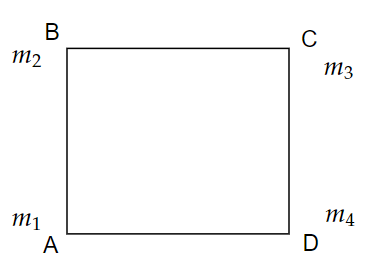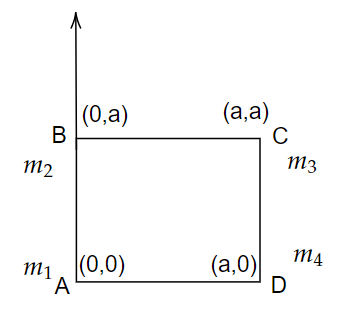
Four particles of masses \[{m_1},{m_2},{m_3}\] and \[{m_4}\]are placed at the vertices A,B,C, and D as shown respectively in the square shown. Then what is the condition for the centre of mass of the system which lies at diagonal AC.

A. \[{m_1} = {m_3}\]
B. \[{m_2} = {m_4}\]
C. \[{m_1} = {m_2}\]
D. \[{m_3} = {m_4}\]
Answer
218.7k+ views
Hint:Here before we proceed with the problem let’s know about the centre of mass. Centre of mass of a body or a system is defined as a point where all of the system’s mass is supposed to be concentrated, and this point like a mass has the same kind of translational motion as the system as a whole, if the same net external force operates on this point like mass as on the system as a whole.
Formula Used:
The formula to find the centre of mass we have,
\[{X_{CM}} = \dfrac{{{m_1}{x_1} + {m_2}{x_2} + {m_3}{x_3} + {m_4}{x_4}}}{{{m_1} + {m_2} + {m_3} + {m_4}}}\]
Where,
\[{m_1},{m_2},{m_3}\] are the masses of three particles.
\[{x_1},{x_2},{x_3}\] are the positions of masses.
Complete step by step solution:

Image: Four particles are placed at the four vertices of a square.
Suppose, consider a square in which all the four particles are placed at all the four vertices as shown and we are going to find the condition for the centre of mass of the system which lies at diagonal AC. The centre of mass\[{X_{CM}}\] is given by,
\[{X_{CM}} = \dfrac{{{m_1}{x_1} + {m_2}{x_2} + {m_3}{x_3} + {m_4}{x_4}}}{{{m_1} + {m_2} + {m_3} + {m_4}}}\]
From diagram, we have \[\left( {{x_1},{y_1}} \right) = \left( {0,0} \right)\] , \[\left( {{x_2},{y_2}} \right) = \left( {0,a} \right)\], \[\left( {{x_3},{y_3}} \right) = \left( {a,a} \right)\] and \[\left( {{x_4},{y_4}} \right) = \left( {a,0} \right)\]
\[{X_{CM}} = \dfrac{{{m_1}\left( 0 \right) + {m_2}\left( 0 \right) + {m_3}\left( a \right) + {m_4}\left( a \right)}}{{{m_1} + {m_2} + {m_3} + {m_4}}} \\ \]
\[\Rightarrow {X_{CM}} = \dfrac{{{m_3}a + {m_4}a}}{{{m_1} + {m_2} + {m_3} + {m_4}}} \\ \]
Similarly,
\[{Y_{CM}} = \dfrac{{{m_1}{y_1} + {m_2}{y_2} + {m_3}{y_3} + {m_4}{y_4}}}{{{m_1} + {m_2} + {m_3} + {m_4}}} \\ \]
\[\Rightarrow {Y_{CM}} = \dfrac{{{m_1}\left( 0 \right) + {m_2}\left( a \right) + {m_3}\left( a \right) + {m_4}\left( 0 \right)}}{{{m_1} + {m_2} + {m_3} + {m_4}}} \\ \]
\[\Rightarrow {Y_{CM}} = \dfrac{{{m_2}\left( a \right) + {m_3}\left( a \right)}}{{{m_1} + {m_2} + {m_3} + {m_4}}} \\ \]
So, if \[{m_2} = {m_4}\] then only the centre of mass of the system will lie at diagonal AC.
Therefore, the condition for the centre of mass in which the system will lie at diagonal AC is,
\[{m_2} = {m_4}\]
Hence, option B is the correct answer.
Note: Remember that, for the square and the rectangular objects, the centre of mass lies at the point where the diagonals meet. The centre of mass is nothing but all the masses are concentrated at the centre of the object or a system. But here, it will lie where the diagonal meets.
Formula Used:
The formula to find the centre of mass we have,
\[{X_{CM}} = \dfrac{{{m_1}{x_1} + {m_2}{x_2} + {m_3}{x_3} + {m_4}{x_4}}}{{{m_1} + {m_2} + {m_3} + {m_4}}}\]
Where,
\[{m_1},{m_2},{m_3}\] are the masses of three particles.
\[{x_1},{x_2},{x_3}\] are the positions of masses.
Complete step by step solution:

Image: Four particles are placed at the four vertices of a square.
Suppose, consider a square in which all the four particles are placed at all the four vertices as shown and we are going to find the condition for the centre of mass of the system which lies at diagonal AC. The centre of mass\[{X_{CM}}\] is given by,
\[{X_{CM}} = \dfrac{{{m_1}{x_1} + {m_2}{x_2} + {m_3}{x_3} + {m_4}{x_4}}}{{{m_1} + {m_2} + {m_3} + {m_4}}}\]
From diagram, we have \[\left( {{x_1},{y_1}} \right) = \left( {0,0} \right)\] , \[\left( {{x_2},{y_2}} \right) = \left( {0,a} \right)\], \[\left( {{x_3},{y_3}} \right) = \left( {a,a} \right)\] and \[\left( {{x_4},{y_4}} \right) = \left( {a,0} \right)\]
\[{X_{CM}} = \dfrac{{{m_1}\left( 0 \right) + {m_2}\left( 0 \right) + {m_3}\left( a \right) + {m_4}\left( a \right)}}{{{m_1} + {m_2} + {m_3} + {m_4}}} \\ \]
\[\Rightarrow {X_{CM}} = \dfrac{{{m_3}a + {m_4}a}}{{{m_1} + {m_2} + {m_3} + {m_4}}} \\ \]
Similarly,
\[{Y_{CM}} = \dfrac{{{m_1}{y_1} + {m_2}{y_2} + {m_3}{y_3} + {m_4}{y_4}}}{{{m_1} + {m_2} + {m_3} + {m_4}}} \\ \]
\[\Rightarrow {Y_{CM}} = \dfrac{{{m_1}\left( 0 \right) + {m_2}\left( a \right) + {m_3}\left( a \right) + {m_4}\left( 0 \right)}}{{{m_1} + {m_2} + {m_3} + {m_4}}} \\ \]
\[\Rightarrow {Y_{CM}} = \dfrac{{{m_2}\left( a \right) + {m_3}\left( a \right)}}{{{m_1} + {m_2} + {m_3} + {m_4}}} \\ \]
So, if \[{m_2} = {m_4}\] then only the centre of mass of the system will lie at diagonal AC.
Therefore, the condition for the centre of mass in which the system will lie at diagonal AC is,
\[{m_2} = {m_4}\]
Hence, option B is the correct answer.
Note: Remember that, for the square and the rectangular objects, the centre of mass lies at the point where the diagonals meet. The centre of mass is nothing but all the masses are concentrated at the centre of the object or a system. But here, it will lie where the diagonal meets.
Recently Updated Pages
Two discs which are rotating about their respective class 11 physics JEE_Main

A ladder rests against a frictionless vertical wall class 11 physics JEE_Main

Two simple pendulums of lengths 1 m and 16 m respectively class 11 physics JEE_Main

The slopes of isothermal and adiabatic curves are related class 11 physics JEE_Main

A trolly falling freely on an inclined plane as shown class 11 physics JEE_Main

The masses M1 and M2M2 M1 are released from rest Using class 11 physics JEE_Main

Trending doubts
JEE Main 2026: Application Form Open, Exam Dates, Syllabus, Eligibility & Question Papers

Derivation of Equation of Trajectory Explained for Students

Hybridisation in Chemistry – Concept, Types & Applications

Understanding the Angle of Deviation in a Prism

Understanding Collisions: Types and Examples for Students

Understanding Atomic Structure for Beginners

Other Pages
JEE Advanced Marks vs Ranks 2025: Understanding Category-wise Qualifying Marks and Previous Year Cut-offs

Units And Measurements Class 11 Physics Chapter 1 CBSE Notes - 2025-26

NCERT Solutions For Class 11 Physics Chapter 8 Mechanical Properties Of Solids

Motion in a Straight Line Class 11 Physics Chapter 2 CBSE Notes - 2025-26

NCERT Solutions for Class 11 Physics Chapter 7 Gravitation 2025-26

How to Convert a Galvanometer into an Ammeter or Voltmeter




